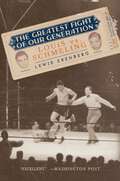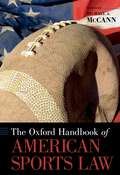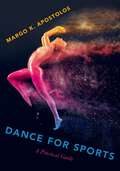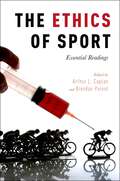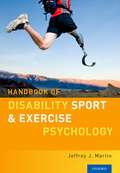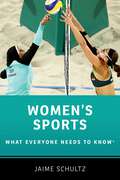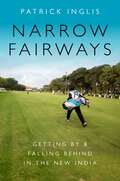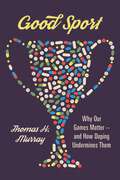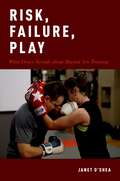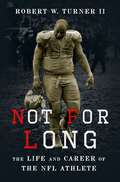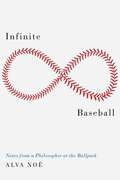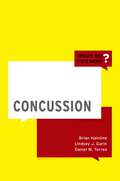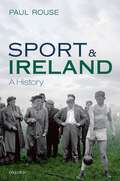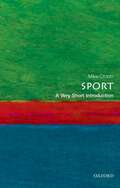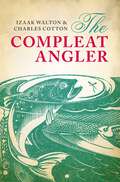- Table View
- List View
The Greatest Fight of Our Generation: Louis vs. Schmeling
by Lewis A. ErenbergHeld on June 22, 1938, in Yankee Stadium, the second Louis-Schmeling fight sparked excitement around the globe. For all its length--the fight lasted but two minutes--it remains one of the most memorable events in boxing history and, indeed, one of the most significant sporting events ever. In this superb account, Lewis A. Erenberg offers a vivid portrait of Joe Louis, Max Schmeling, their individual careers, and their two epic fights, shedding light on what these fighters represented to their nations, and why their second bout took on such international importance. Erenberg shows how in the first fight Schmeling shocked everyone with a dramatic twelfth-round knockout of Louis, becoming a German national hero and a (unwilling) symbol of Aryan superiority. In fact, the second fight was seen around the world in symbolic terms--as a match between Nazism and American democracy. Erenberg discusses how Louis' dramatic first-round victory was a devastating blow to Hitler, who turned on Schmeling and, during the war, had the boxer (then serving as a paratrooper) sent on a series of dangerous missions. Louis, meanwhile, went from being a hero of his race--"Our Joe"--to the first black champion embraced by all Americans, black and white, an important step forward in United States race relations. Erenberg also describes how, after the war, the two boxers became symbols of German-American reconciliation. With Schmeling as a Coca Cola executive, and Louis down on his luck, the former foes became friends, and when Louis died, Schmeling helped pay for his funeral. Here then is a stirring and insightful account of one of the great moments in boxing history, a confrontation that provided global theater on an epic scale.
The Oxford Handbook of American Sports Law (Oxford Handbooks)
The Oxford Handbook of American Sports Law takes the reader through the most important controversies and critical developments in law and U.S. sports. Over the course of 30 chapters, leading scholars explore this expanding and captivating area of law. The Handbook is the first book to gather dozens of perspectives on sports law controversies in the United States, and will be of interest to those who study and practice sports law, as well as journalists, broadcasters, and legally minded sports fans. The Oxford Handbook of American Sports Law incorporates analysis of key historical events in sports law-such as the rise of free agency in professional sports and the concept of "amateurism" for college athletes-and their broader context. Contemporary legal controversies in U.S. sports and their accompanying questions are also of central importance: In a sensible legal system, how would long-term neurological injuries from contact sports be addressed? How would the use of racially insensitive team names be resolved? How would a seemingly trivial dispute over air pressure in footballs be studied from the competing perspectives of players, teams, and leagues? The Oxford Handbook of American Sports Law weighs not just the facts, but how courts and lawmakers ought to consider the most important questions at stake. The essays in this volume also canvass the types of legal controversies in sports likely to surface in the future. This is particularly true of law and technology matters, including those related to broadcasting and streaming. Legal doctrine has been and will continue to be forced to adapt to these developments, and the Handbook both forecasts coming debates and outlines where the law may be headed.
Dance for Sports: A Practical Guide
by Margo K. ApostolosIn Dance for Sports, author, teacher, dancer, athlete, and researcher Margo Apostolos offers a new training approach for athletes and coaches that synthesizes common techniques between athletics and dance. By utilizing this approach, in- and off-season athletes can improve efficiency and technique. Throughout the book, Apostolos shows the potential exchange between sport and dance in exercises that focus on overlapping physical components of both practices including flexibility, strength, coordination, agility, balance, and timing. She also demonstrates how dance serves sport as a cross training activity with additional opportunities for athletes to explore creativity, improvisation, and mindfulness. Discussion with athletes from several sports interweaves each chapter to expand the learning process and offer useful anecdotes. Based upon the author's decades-long career and extensive experience with athletes and coaches in a variety of sports such as football, basketball, swimming, tennis, track and field and more, Dance for Sports provides a fully integrative guide for students and instructors alike.
DANCE FOR SPORTS C: A Practical Guide
by Margo K. ApostolosIn Dance for Sports, author, teacher, dancer, athlete, and researcher Margo Apostolos offers a new training approach for athletes and coaches that synthesizes common techniques between athletics and dance. By utilizing this approach, in- and off-season athletes can improve efficiency and technique. Throughout the book, Apostolos shows the potential exchange between sport and dance in exercises that focus on overlapping physical components of both practices including flexibility, strength, coordination, agility, balance, and timing. She also demonstrates how dance serves sport as a cross training activity with additional opportunities for athletes to explore creativity, improvisation, and mindfulness. Discussion with athletes from several sports interweaves each chapter to expand the learning process and offer useful anecdotes. Based upon the author's decades-long career and extensive experience with athletes and coaches in a variety of sports such as football, basketball, swimming, tennis, track and field and more, Dance for Sports provides a fully integrative guide for students and instructors alike.
ETHICS OF SPORT ESSENTIAL READINGS C: Essential Readings
by Arthur L. Caplan and Brendan ParentSport is often thought of as simply "games," but it can in fact be much more. Sport can be responsible for guiding social justice movements, igniting city-wide riots, uniting countries, permanently injuring youth, revolutionizing views about race, gender and class, and producing several of the most successful global industries. Reports of ethical crises in athletics are constant fodder for popular attention, whether performance enhancing drugs in baseball, corruption in college athletics, the epidemic of brain damage among NFL players, and others too numerous to mention. As a proxy for social concerns, we naturally think of sport in inherently moral terms. Yet we can hardly define the term "sport" or agree on acceptable levels of sporting risk, or determine clear roles and responsibilities for fans, players, coaches, owners, media and health care personnel. Bringing together 27 of the most essential recent articles from philosophy, history, sociology, medicine, and law, this collection explores intersections of sports and ethics and brings attention to the immense role of sports in shaping and reflecting social values.
Handbook of Disability Sport and Exercise Psychology
by Jeffrey J. MartinHistorically, very few sport and exercise psychologists and professionals from related fields such as disability and rehabilitation have conducted thorough research on individuals with disabilities engaged in sport and exercise. The tide is turning, however, as growing media attention and familiarity with the Paralympics and the Wounded Warrior Project begins capturing the attention of researchers everywhere. By addressing this gap, Jeffrey J. Martin's compelling Handbook of Disability Sport and Exercise Psychology is one of the first comprehensive overviews of this important and emerging field of study. In this volume, Martin, an accomplished professor of sport and exercise psychology, shines a light on a variety of topics ranging from philosophy, athletic identity, participation motivation, quality of life, social and environmental barriers, body image, and intellectual impairments among many other issues. Based on the author's own experience and insight, a majority of these topic discussions in this volume are accompanied by thoughtful directions for future research and exploration. Designed to spark conversation and initiate new avenues of research, the Handbook of Disability Sport and Exercise Psychology will allow for readers to look outside the traditional literature focusing largely on able-bodied individuals and, instead, develop a much greater perspective on sport and exercise psychology today.
Women's Sports: What Everyone Needs to Know® (What Everyone Needs To Know®)
by Jaime SchultzAlthough girls and women account for approximately 40 percent of all athletes in the United States, they receive only 4 percent of the total sport media coverage. SportsCenter, ESPN's flagship program, dedicates less than 2 percent of its airtime to women. Local news networks devote less than 5 percent of their programming to women's sports. Excluding Sports Illustrated's annual "Swimsuit Issue," women appear on just 4.9 percent of the magazine's covers. Media is a powerful indication of the culture surrounding sport in the United States. Why are women underrepresented in sports media? Sports Illustrated journalist Andy Benoit infamously remarked that women's sports "are not worth watching." Although he later apologized, Benoit's comment points to more general lack of awareness. Consider, for example, the confusion surrounding Title IX, the U.S. Law that prohibits sex discrimination in any educational program that receives federal financial assistance. Is Title IX to blame when administrators drop men's athletic programs? Is it lack of interest or lack of opportunity that causes girls and women to participate in sport at lower rates than boys and men? In Women's Sports: What Everyone Needs to Know®, Jaime Schultz tackles these questions, along with many others, to upend the misunderstandings that plague women's sports. Using historical, contemporary, scholarly, and popular sources, Schultz traces the progress and pitfalls of women's involvement in sport. In the signature question-and-answer format of the What Everyone Needs to Know® series, this short and accessible book clarifies misconceptions that dog women's athletics and offers much needed context and history to illuminate the struggles and inequalities sportswomen continue to face. By exploring issues such as gender, sexuality, sex segregation, the Olympic and Paralympic Games, media coverage, and the sport-health connection, Schultz shows why women's sports are not just worth watching, but worth playing, supporting, and fighting for.
WOMEN'S SPORTS WENK C: What Everyone Needs to Know® (What Everyone Needs To Know®)
by Jaime SchultzAlthough girls and women account for approximately 40 percent of all athletes in the United States, they receive only 4 percent of the total sport media coverage. SportsCenter, ESPN's flagship program, dedicates less than 2 percent of its airtime to women. Local news networks devote less than 5 percent of their programming to women's sports. Excluding Sports Illustrated's annual "Swimsuit Issue," women appear on just 4.9 percent of the magazine's covers. Media is a powerful indication of the culture surrounding sport in the United States. Why are women underrepresented in sports media? Sports Illustrated journalist Andy Benoit infamously remarked that women's sports "are not worth watching." Although he later apologized, Benoit's comment points to more general lack of awareness. Consider, for example, the confusion surrounding Title IX, the U.S. Law that prohibits sex discrimination in any educational program that receives federal financial assistance. Is Title IX to blame when administrators drop men's athletic programs? Is it lack of interest or lack of opportunity that causes girls and women to participate in sport at lower rates than boys and men? In Women's Sports: What Everyone Needs to Know®, Jaime Schultz tackles these questions, along with many others, to upend the misunderstandings that plague women's sports. Using historical, contemporary, scholarly, and popular sources, Schultz traces the progress and pitfalls of women's involvement in sport. In the signature question-and-answer format of the What Everyone Needs to Know® series, this short and accessible book clarifies misconceptions that dog women's athletics and offers much needed context and history to illuminate the struggles and inequalities sportswomen continue to face. By exploring issues such as gender, sexuality, sex segregation, the Olympic and Paralympic Games, media coverage, and the sport-health connection, Schultz shows why women's sports are not just worth watching, but worth playing, supporting, and fighting for.
Narrow Fairways: Getting By & Falling Behind in the New India (Global and Comparative Ethnography)
by Patrick InglisIndia remains a country mired in poverty, with two-thirds of its 1.3 billion people living on little more than a few dollars a day. Just as telling, the country's informal working population numbers nearly 500 million, or approximately eighty percent of the entire labor force. Despite these figures and the related structural disadvantages that imperil the lives of so many, the Indian elite maintain that the poor need only work harder and they, too, can become rich. The results of this ambitious ten-year ethnography at exclusive golf clubs in Bangalore shatter such self-serving illusions. In Narrow Fairways, Patrick Inglis combines participant observation, interviews, and archival research to show how social mobility among the poor lower-caste golf caddies who carry the golf sets of wealthy upper-caste members at these clubs is ultimately constrained and narrowed. The book highlights how elites secure and extend class and caste privileges, while also delivering a necessary rebuke to India's present development strategy, which pays far too little attention to promoting quality healthcare, education, and other basic social services that would deliver real opportunities to the poor.
NARROW FAIRWAYS GCE C: Getting By & Falling Behind in the New India (Global and Comparative Ethnography)
by Patrick InglisIndia remains a country mired in poverty, with two-thirds of its 1.3 billion people living on little more than a few dollars a day. Just as telling, the country's informal working population numbers nearly 500 million, or approximately eighty percent of the entire labor force. Despite these figures and the related structural disadvantages that imperil the lives of so many, the Indian elite maintain that the poor need only work harder and they, too, can become rich. The results of this ambitious ten-year ethnography at exclusive golf clubs in Bangalore shatter such self-serving illusions. In Narrow Fairways, Patrick Inglis combines participant observation, interviews, and archival research to show how social mobility among the poor lower-caste golf caddies who carry the golf sets of wealthy upper-caste members at these clubs is ultimately constrained and narrowed. The book highlights how elites secure and extend class and caste privileges, while also delivering a necessary rebuke to India's present development strategy, which pays far too little attention to promoting quality healthcare, education, and other basic social services that would deliver real opportunities to the poor.
Good Sport: Why Our Games Matter -- and How Doping Undermines Them
by Thomas H. MurrayWhy are fiberglass vaulting poles and hinged skates accepted in sport - while performance-enhancing drugs are forbidden? Are the rules that forbid them arbitrary? Should we level the playing field by allowing all competitors to use drugs that allow them to run faster or longer, leap higher, or lift more? In this provocative exploration of what draws us to sport as participants and spectators, Thomas Murray argues that the values and meanings embedded within our games provide the guidance we need to make difficult decisions about fairness and performance-enhancing technologies. Good Sport reveals what we really care about in sport and how the reckless use of biomedical enhancements undermines those values. Implicit in sports history, rules, and practices are values that provide a sturdy foundation for an ethics of sport that celebrates natural talents and dedication. You see these values when the Paralympics creates multiple level playing fields among athletes with different kinds of impairments. They appear again in sports struggles to be fair to all when an extraordinary woman athlete emerges who appears to possess a mans hormone profile and muscles. They are threatened when the effort to assure athletes a fair chance to win without doping is subverted by cheating or by corruption, as in the case of Russias state-supported doping operation. Performance-enhancing drugs distort the connection between natural talents, the dedication to perfect those talents, and success in sport. Explaining the fundamental role of values and meanings, Good Sport reveals not just what we champion in the athletic arena but also, more broadly, what we value in human achievement.
Good Sport: Why Our Games Matter -- and How Doping Undermines Them
by Thomas H. MurrayWhy are fiberglass vaulting poles and hinged skates accepted in sport - while performance-enhancing drugs are forbidden? Are the rules that forbid them arbitrary? Should we level the playing field by allowing all competitors to use drugs that allow them to run faster or longer, leap higher, or lift more? In this provocative exploration of what draws us to sport as participants and spectators, Thomas Murray argues that the values and meanings embedded within our games provide the guidance we need to make difficult decisions about fairness and performance-enhancing technologies. Good Sport reveals what we really care about in sport and how the reckless use of biomedical enhancements undermines those values. Implicit in sports history, rules, and practices are values that provide a sturdy foundation for an ethics of sport that celebrates natural talents and dedication. You see these values when the Paralympics creates multiple level playing fields among athletes with different kinds of impairments. They appear again in sports struggles to be fair to all when an extraordinary woman athlete emerges who appears to possess a mans hormone profile and muscles. They are threatened when the effort to assure athletes a fair chance to win without doping is subverted by cheating or by corruption, as in the case of Russias state-supported doping operation. Performance-enhancing drugs distort the connection between natural talents, the dedication to perfect those talents, and success in sport. Explaining the fundamental role of values and meanings, Good Sport reveals not just what we champion in the athletic arena but also, more broadly, what we value in human achievement.
Handbook of Disability Sport and Exercise Psychology
by Jeffrey J. MartinHistorically, very few sport and exercise psychologists and professionals from related fields such as disability and rehabilitation have conducted thorough research on individuals with disabilities engaged in sport and exercise. The tide is turning, however, as growing media attention and familiarity with the Paralympics and the Wounded Warrior Project begins capturing the attention of researchers everywhere. By addressing this gap, Jeffrey J. Martin's compelling Handbook of Disability Sport and Exercise Psychology is one of the first comprehensive overviews of this important and emerging field of study. In this volume, Martin, an accomplished professor of sport and exercise psychology, shines a light on a variety of topics ranging from philosophy, athletic identity, participation motivation, quality of life, social and environmental barriers, body image, and intellectual impairments among many other issues. Based on the author's own experience and insight, a majority of these topic discussions in this volume are accompanied by thoughtful directions for future research and exploration. Designed to spark conversation and initiate new avenues of research, the Handbook of Disability Sport and Exercise Psychology will allow for readers to look outside the traditional literature focusing largely on able-bodied individuals and, instead, develop a much greater perspective on sport and exercise psychology today.
The Oxford Handbook of American Sports Law (Oxford Handbooks)
by Michael A. McCannThe Oxford Handbook of American Sports Law takes the reader through the most important controversies and critical developments in law and U.S. sports. Over the course of 30 chapters, leading scholars explore this expanding and captivating area of law. The Handbook is the first book to gather dozens of perspectives on sports law controversies in the United States, and will be of interest to those who study and practice sports law, as well as journalists, broadcasters, and legally minded sports fans. The Oxford Handbook of American Sports Law incorporates analysis of key historical events in sports law-such as the rise of free agency in professional sports and the concept of "amateurism" for college athletes-and their broader context. Contemporary legal controversies in U.S. sports and their accompanying questions are also of central importance: In a sensible legal system, how would long-term neurological injuries from contact sports be addressed? How would the use of racially insensitive team names be resolved? How would a seemingly trivial dispute over air pressure in footballs be studied from the competing perspectives of players, teams, and leagues? The Oxford Handbook of American Sports Law weighs not just the facts, but how courts and lawmakers ought to consider the most important questions at stake. The essays in this volume also canvass the types of legal controversies in sports likely to surface in the future. This is particularly true of law and technology matters, including those related to broadcasting and streaming. Legal doctrine has been and will continue to be forced to adapt to these developments, and the Handbook both forecasts coming debates and outlines where the law may be headed.
Risk, Failure, Play: What Dance Reveals about Martial Arts Training
by Janet O'SheaRisk, Failure, Play illuminates the many ways in which competitive martial arts differentiate themselves from violence. Presented from the perspective of a dancer and writer, this book takes readers through the politics of everyday life as experienced through training in a range of martial arts practices such as jeet kune do, Brazilian jiu jitsu, kickboxing, Filipino martial arts, and empowerment self-defense. Author Janet OâShea shows how play gives us the ability to manage difficult realities with intelligence and demonstrates that physical play, with its immediacy and heightened risk, is particularly effective at accomplishing this task. Risk, Failure, Play also demonstrates the many ways in which physical recreation allows us to manage the complexities of our current social reality. Risk, Failure, Play intertwines personal experience with phenomenology, social psychology, dance studies, performance studies, as well as theories of play and competition in order to produce insights on pleasure, mastery, vulnerability, pain, agency, individual identity, and society. Ultimately, this book suggests that play allows us to rehearse other ways to live than the ones we see before us and challenges us to reimagine our social reality.
RISK, FAILURE, PLAY C: What Dance Reveals about Martial Arts Training
by Janet O'SheaRisk, Failure, Play illuminates the many ways in which competitive martial arts differentiate themselves from violence. Presented from the perspective of a dancer and writer, this book takes readers through the politics of everyday life as experienced through training in a range of martial arts practices such as jeet kune do, Brazilian jiu jitsu, kickboxing, Filipino martial arts, and empowerment self-defense. Author Janet OâShea shows how play gives us the ability to manage difficult realities with intelligence and demonstrates that physical play, with its immediacy and heightened risk, is particularly effective at accomplishing this task. Risk, Failure, Play also demonstrates the many ways in which physical recreation allows us to manage the complexities of our current social reality. Risk, Failure, Play intertwines personal experience with phenomenology, social psychology, dance studies, performance studies, as well as theories of play and competition in order to produce insights on pleasure, mastery, vulnerability, pain, agency, individual identity, and society. Ultimately, this book suggests that play allows us to rehearse other ways to live than the ones we see before us and challenges us to reimagine our social reality.
Not for Long: The Life and Career of the NFL Athlete
by Robert W. Turner IIThe NFL is the most popular professional sports league in the United States. Its athletes receive multimillion-dollar contracts and almost endless media attention. The league's most important game, the Super Bowl, is practically a national holiday. Making it to the NFL, however, is not about the promised land of fame and fortune. Robert W. Turner II draws on his personal experience as a former professional football player as well as interviews with more than 140 current and former NFL players to reveal what it means to be an athlete in the NFL and explain why so many players struggle with life after football. Without guaranteed contracts, the majority of players are forced out of the league after a few seasons. Over three-quarters of retirees experience bankruptcy or financial ruin, two-thirds live with chronic pain, and too many find themselves on the wrong side of the law. Robert W. Turner II argues that the fall from grace of so many players is no accident. The NFL, he contends, powerfully determines their experiences in and out of the league. The labor agreement provides little job security and few health and retirement benefits, and the owners refuse to share power with the players, making change difficult. And the process of becoming an elite football player--from high school to college and through the pros--leaves athletes with few marketable skills and little preparation for their first Sunday off the field. With compassion and objectivity, Not for Long reveals the life and mind of high school, college, and NFL athletes, shedding light on what might best help players transition successfully out of the sport.
Infinite Baseball: Notes from a Philosopher at the Ballpark
by Alva NoëBaseball is a strange sport: it consists of long periods in which little seems to be happening, punctuated by high-energy outbursts of rapid fire activity. Because of this, despite ever greater profits, Major League Baseball is bent on finding ways to shorten games, and to tailor baseball to today's shorter attention spans. But for the true fan, baseball is always compelling to watch -and intellectually fascinating. It's superficially slow-pace is an opportunity to participate in the distinctive thinking practice that defines the game. If baseball is boring, it's boring the way philosophy is boring: not because there isn't a lot going on, but because the challenge baseball poses is making sense of it all. In this deeply entertaining book, philosopher and baseball fan Alva Noë explores the many unexpected ways in which baseball is truly a philosophical kind of game. For example, he ponders how observers of baseball are less interested in what happens, than in who is responsible for what happens; every action receives praise or blame. To put it another way, in baseball - as in the law - we decide what happened based on who is responsible for what happened. Noe also explains the curious activity of keeping score: a score card is not merely a record of the game, like a video recording; it is an account of the game. Baseball requires that true fans try to tell the story of the game, in real time, as it unfolds, and thus actively participate in its creation. Some argue that baseball is fundamentally a game about numbers. Noe's wide-ranging, thoughtful observations show that, to the contrary, baseball is not only a window on language, culture, and the nature of human action, but is intertwined with deep and fundamental human truths. The book ranges from the nature of umpiring and the role of instant replay, to the nature of the strike zone, from the rampant use of surgery to controversy surrounding performance enhancing drugs. Throughout, Noe's observations are surprising and provocative. Infinite Baseball is a book for the true baseball fan.
Infinite Baseball: Notes from a Philosopher at the Ballpark
by Alva NoëBaseball is a strange sport: it consists of long periods in which little seems to be happening, punctuated by high-energy outbursts of rapid fire activity. Because of this, despite ever greater profits, Major League Baseball is bent on finding ways to shorten games, and to tailor baseball to today's shorter attention spans. But for the true fan, baseball is always compelling to watch -and intellectually fascinating. It's superficially slow-pace is an opportunity to participate in the distinctive thinking practice that defines the game. If baseball is boring, it's boring the way philosophy is boring: not because there isn't a lot going on, but because the challenge baseball poses is making sense of it all. In this deeply entertaining book, philosopher and baseball fan Alva Noë explores the many unexpected ways in which baseball is truly a philosophical kind of game. For example, he ponders how observers of baseball are less interested in what happens, than in who is responsible for what happens; every action receives praise or blame. To put it another way, in baseball - as in the law - we decide what happened based on who is responsible for what happened. Noe also explains the curious activity of keeping score: a score card is not merely a record of the game, like a video recording; it is an account of the game. Baseball requires that true fans try to tell the story of the game, in real time, as it unfolds, and thus actively participate in its creation. Some argue that baseball is fundamentally a game about numbers. Noe's wide-ranging, thoughtful observations show that, to the contrary, baseball is not only a window on language, culture, and the nature of human action, but is intertwined with deep and fundamental human truths. The book ranges from the nature of umpiring and the role of instant replay, to the nature of the strike zone, from the rampant use of surgery to controversy surrounding performance enhancing drugs. Throughout, Noe's observations are surprising and provocative. Infinite Baseball is a book for the true baseball fan.
Concussion (What Do I Do Now)
by Brian Hainline Lindsey J. Gurin Daniel M. TorresPart of the "What Do I Do Now? series, Concussion uses a case-based approach to cover common and important topics in the examination, investigation, and management of acute and subacute concussion. Each chapter provides a discussion of the diagnosis, key points to remember, and selected references for further reading. The book addresses a wide range of topics that run the spectrum from acute concussion to the possibility of long-term sequelae of concussion, and is suited for physicians and sports medicine clinicians. Concussion is an engaging collection of thought-provoking cases which clinicians can utilize when they encounter difficult patients. The volume is also a self-assessment tool that tests the reader's ability to answer the question, "What do I do now?"
Concussion (What Do I Do Now)
by Brian Hainline Lindsey J. Gurin Daniel M. TorresPart of the "What Do I Do Now? series, Concussion uses a case-based approach to cover common and important topics in the examination, investigation, and management of acute and subacute concussion. Each chapter provides a discussion of the diagnosis, key points to remember, and selected references for further reading. The book addresses a wide range of topics that run the spectrum from acute concussion to the possibility of long-term sequelae of concussion, and is suited for physicians and sports medicine clinicians. Concussion is an engaging collection of thought-provoking cases which clinicians can utilize when they encounter difficult patients. The volume is also a self-assessment tool that tests the reader's ability to answer the question, "What do I do now?"
Sport and Ireland: A History
by Paul RouseThis is the first history of sport in Ireland, locating the history of sport within Irish political, social, and cultural history, and within the global history of sport. Sport and Ireland demonstrates that there are aspects of Ireland's sporting history that are uniquely Irish and are defined by the peculiarities of life on a small island on the edge of Europe. What is equally apparent, though, is that the Irish sporting world is unique only in part; much of the history of Irish sport is a shared history with that of other societies. Drawing on an unparalleled range of sources - government archives, sporting institutions, private collections, and more than sixty local, national, and international newspapers - this volume offers a unique insight into the history of the British Empire in Ireland and examines the impact that political partition has had on the organization of sport there. Paul Rouse assesses the relationship between sport and national identity, how sport influences policy-making in modern states, and the ways in which sport has been colonized by the media and has colonized it in turn. Each chapter of Sport and Ireland contains new research on the place of sport in Irish life: the playing of hurling matches in London in the eighteenth century, the growth of cricket to become the most important sport in early Victorian Ireland, and the enlistment of thousands of members of the Gaelic Athletic Association as soldiers in the British Army during the Great War. Rouse draws out the significance of animals to the Irish sporting tradition, from the role of horse and dogs in racing and hunting, to the cocks, bulls, and bears that were involved in fighting and baiting.
Sport and Ireland: A History
by Paul RouseThis is the first history of sport in Ireland, locating the history of sport within Irish political, social, and cultural history, and within the global history of sport. Sport and Ireland demonstrates that there are aspects of Ireland's sporting history that are uniquely Irish and are defined by the peculiarities of life on a small island on the edge of Europe. What is equally apparent, though, is that the Irish sporting world is unique only in part; much of the history of Irish sport is a shared history with that of other societies. Drawing on an unparalleled range of sources - government archives, sporting institutions, private collections, and more than sixty local, national, and international newspapers - this volume offers a unique insight into the history of the British Empire in Ireland and examines the impact that political partition has had on the organization of sport there. Paul Rouse assesses the relationship between sport and national identity, how sport influences policy-making in modern states, and the ways in which sport has been colonized by the media and has colonized it in turn. Each chapter of Sport and Ireland contains new research on the place of sport in Irish life: the playing of hurling matches in London in the eighteenth century, the growth of cricket to become the most important sport in early Victorian Ireland, and the enlistment of thousands of members of the Gaelic Athletic Association as soldiers in the British Army during the Great War. Rouse draws out the significance of animals to the Irish sporting tradition, from the role of horse and dogs in racing and hunting, to the cocks, bulls, and bears that were involved in fighting and baiting.
Sport: Ireland's Sporting Heritage (Sport In The Global Society Ser.)
by Mike CroninSport is big business; international in nature and the focus of much media and cultural attention. In this Very Short Introduction, Mike Cronin charts the history of sport, from its traditional origins in folk football and cock fighting to its position as a global phenomenon today. Looking at a variety of sports from team games such as rugby, cricket, and football to games for individuals such as golf, tennis, and skiing, he considers how these first emerged and captivated the interest of ordinary people, and how sport has been transformed within our daily lives. Exploring the relationship between sport and class, gender, commerce, identity, and ethics, Cronin considers some of the central issues in sport today, including the high pay of professional footballers and the glamour of sports women, as well as fair play standards. Charting sport through the ages and around the world, this is a short guide to the history, development, and place of sport in contemporary global society. ABOUT THE SERIES: The Very Short Introductions series from Oxford University Press contains hundreds of titles in almost every subject area. These pocket-sized books are the perfect way to get ahead in a new subject quickly. Our expert authors combine facts, analysis, perspective, new ideas, and enthusiasm to make interesting and challenging topics highly readable.
The Compleat Angler (Oxford World's Classics)
by Izaak Walton Charles Cotton'I envy no body but him, and him only, that catches more fish than I do.' A unique celebration of the English countryside and the most famous book on angling ever published, Walton's Compleat Angler first appeared in 1653. In 1676, at Walton's invitation, his friend Charles Cotton contributed his pioneering exploration of fly-fishing. The book is both a manual of instruction and a vision of society in harmony with nature. It guides the novice fisherman on how to catch and cook a variety of fish, on how to select and prepare the best bait and make artificial flies, and on the habits of freshwater fish. It also promotes angling as a communal activity in which the bonds of friendship are forged through shared experience of the natural world. Anecdotes, poetry, music, and song intersperse the rural descriptions, which promote conservation as well as sport. This new edition highlights the book's continuing relevance to our relationship with the environment, and explores the turbulent history from which it came. ABOUT THE SERIES: For over 100 years Oxford World's Classics has made available the widest range of literature from around the globe. Each affordable volume reflects Oxford's commitment to scholarship, providing the most accurate text plus a wealth of other valuable features, including expert introductions by leading authorities, helpful notes to clarify the text, up-to-date bibliographies for further study, and much more.
